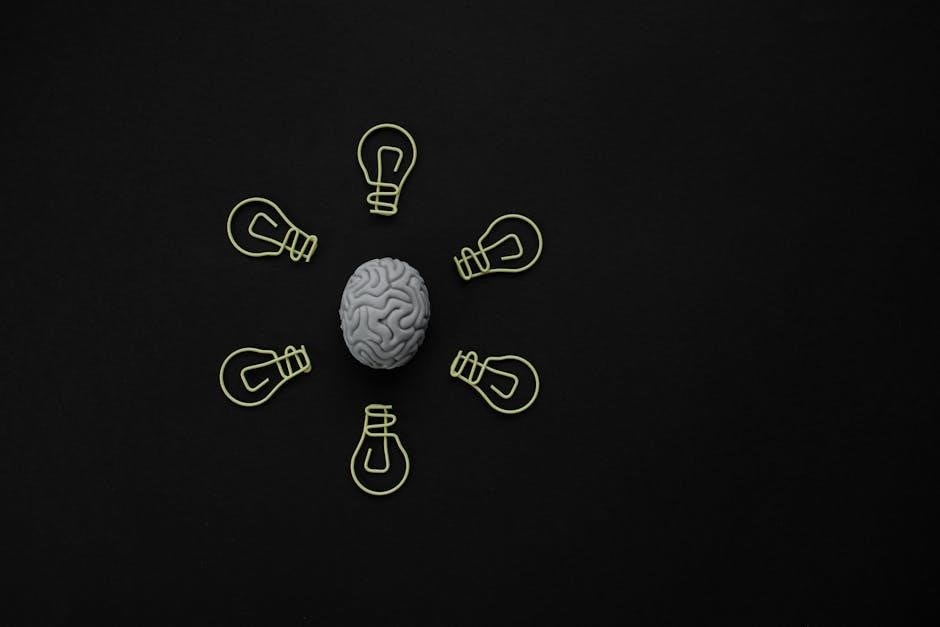The Mini-Mental Status Test (MMST) is a widely used standardized tool to assess cognitive function and detect cognitive impairment․ Developed by Marshall Folstein in 1975‚ it is a brief‚ structured exam taking about 10 minutes to complete․
1․1 Definition and Purpose of the MMST
The Mini-Mental Status Test (MMST) is a standardized‚ 30-point assessment tool designed to evaluate cognitive function and detect potential cognitive impairment․ It is widely used in clinical and research settings to measure various cognitive domains‚ including orientation‚ registration‚ attention‚ memory‚ language‚ and visuospatial ability․ The test is brief‚ typically taking 10 minutes to administer‚ making it a practical tool for initial cognitive screening․
The primary purpose of the MMST is to identify individuals with cognitive deficits‚ such as those associated with dementia or delirium․ It provides a quantitative measure of cognitive impairment‚ with scores ranging from 0 to 30․ Higher scores indicate better cognitive function‚ while lower scores suggest significant impairment․ The test is not diagnostic but serves as a useful screening instrument to guide further evaluation․ Its simplicity and effectiveness make it a valuable resource for healthcare professionals in assessing mental status․
While the MMST is not a comprehensive diagnostic tool‚ it is highly effective for monitoring changes in cognitive function over time and for identifying individuals who may require more detailed neuropsychological assessment․ Its widespread use underscores its importance in both clinical practice and research settings․
1․2 Historical Background and Development
The Mini-Mental Status Test (MMST) was first introduced in 1975 by Marshall Folstein‚ Susan Folstein‚ and Paul McHugh as a practical tool for assessing cognitive impairment in clinical settings․ It emerged during a period when there was a growing need for a brief‚ standardized method to evaluate mental status‚ particularly in elderly populations․
The test was developed to address the limitations of earlier‚ more lengthy cognitive assessments․ Its design was influenced by existing mental status examinations but incorporated a more structured and quantifiable approach․ The MMST gained popularity rapidly due to its simplicity‚ brevity‚ and effectiveness in detecting cognitive deficits․
Over the years‚ the MMST has undergone minimal changes‚ maintaining its original structure while being adapted for use in diverse populations․ It has been translated into multiple languages and is widely recognized as a gold standard for cognitive screening․ Its enduring relevance lies in its ability to provide a quick yet comprehensive assessment of cognitive function‚ making it indispensable in both clinical practice and research․
The MMST’s development marked a significant advancement in neuropsychiatric assessment‚ enabling healthcare professionals to identify cognitive impairments more efficiently and reliably․

Structure of the Mini-Mental Status Test
The Mini-Mental Status Test (MMST) is divided into six key sections: Orientation‚ Registration‚ Attention and Calculation‚ Memory‚ Language‚ and Visuospatial Ability․ Each section assesses specific cognitive functions‚ providing a comprehensive evaluation of mental status․
2․1 Orientation
The Orientation section of the Mini-Mental Status Test assesses a patient’s awareness of time‚ place‚ and person․ It includes questions about the current date‚ time‚ location‚ and sometimes personal information like name and age․ This section evaluates the patient’s ability to accurately perceive their surroundings and reality․ Each correct answer earns a point‚ with a maximum score of 10 in this section․ Proper scoring is essential‚ as it helps determine the level of cognitive impairment․ The Orientation section is fundamental in understanding a patient’s basic cognitive function and serves as a starting point for further evaluation․
2․2 Registration
The Registration section of the Mini-Mental Status Test evaluates the ability to register information․ Patients are asked to repeat three unrelated words‚ such as “apple‚” “table‚” and “door‚” immediately after they are stated․ This task assesses immediate memory and attention․ Each correctly repeated word earns one point‚ with a maximum score of 3․ The examiner repeats the words until the patient learns all three‚ if possible․ This section is crucial for identifying impairments in memory acquisition and attention․ Proper scoring is essential‚ as it contributes to the overall assessment of cognitive function․ A lower score may indicate difficulties in registering new information‚ which can be a sign of cognitive impairment․ The Registration section is a key component in determining the patient’s ability to process and retain simple information effectively․
2․3 Attention and Calculation
The Attention and Calculation section of the Mini-Mental Status Test evaluates the patient’s ability to focus and perform mental tasks․ A common exercise is asking the patient to count backward by sevens starting from 100 (e․g․‚ 100‚ 93‚ 86‚ etc․)‚ which tests serial subtraction․ Another task involves spelling “WORLD” backward‚ assessing attention and cognitive flexibility․ Patients are also given a three-stage command‚ such as touching their nose‚ then their left ear‚ and finally their right hand‚ with each step scored individually․ Scoring is based on accuracy and completion of tasks․ This section helps identify deficits in concentration‚ working memory‚ and executive function․ Proper administration ensures reliable results‚ as subtle errors can indicate cognitive impairment․ The Attention and Calculation subset is a critical component of the MMST‚ providing insights into the patient’s ability to manage complex cognitive processes effectively․
2․4 Memory
The Memory section of the Mini-Mental Status Test assesses short-term memory by asking the patient to recall three unrelated objects․ The examiner names the objects clearly and slowly‚ then later asks the patient to repeat them․ Each correct recall earns one point‚ with a maximum score of three․ This task evaluates the ability to retain and retrieve new information‚ which is essential for diagnosing memory impairments․ If the patient cannot recall an object‚ they score zero for that item․ Memory deficits in this section may indicate conditions such as dementia or other cognitive disorders․ The simplicity of this task makes it an effective tool for identifying memory dysfunction․ Proper administration ensures accurate results‚ as subtle difficulties in recall can be early signs of cognitive decline․ This section is crucial for understanding the patient’s memory function and its impact on overall cognitive health․

2․5 Language
The Language section of the Mini-Mental Status Test evaluates various aspects of linguistic function․ It includes tasks such as naming objects (e․g․‚ identifying a pencil)‚ repeating phrases (e․g․‚ “No ifs‚ ands‚ or buts”)‚ reading simple commands (e․g․‚ “Close your eyes”)‚ writing a sentence‚ and drawing a geometric shape․ Each task is scored based on accuracy‚ with points awarded for correct responses․ This section assesses expressive and receptive language abilities‚ which are critical for communication․ Impairments in this domain may suggest conditions such as aphasia or dementia․ The examiner ensures clarity in instructions to avoid confusion; Scoring reflects the patient’s ability to understand and execute language-based commands․ This part of the test is essential for identifying deficits in verbal and non-verbal communication‚ providing insights into cognitive health․ Proper administration ensures reliable results‚ making it a vital component of the MMST․ Language deficits can indicate significant cognitive impairments‚ emphasizing the importance of this section․
2․6 Visuospatial Ability
The Visuospatial Ability section of the Mini-Mental Status Test assesses the patient’s capacity to understand and interpret visual and spatial information․ A key task involves drawing a clock face and setting the time‚ which evaluates the ability to construct and understand spatial relationships․ The patient is asked to draw the clock with numbers and hands pointing to a specific time‚ such as “3:00․” This task tests both visuospatial skills and the ability to follow instructions․ The examiner scores the drawing based on accuracy‚ with deductions for errors like missing numbers‚ incorrect placement of hands‚ or distortion of the clock’s shape․ This section is crucial for identifying visuospatial deficits‚ which are common in conditions like dementia or Alzheimer’s disease․ Proper administration ensures the patient’s drawing is not influenced by motor impairments‚ focusing solely on cognitive function․ The results help clinicians assess the severity of cognitive decline and monitor changes over time․ This section is a critical component of the MMST‚ providing valuable insights into spatial reasoning and visual processing abilities․

Scoring and Interpretation of the MMST
The MMST is scored out of 30 points‚ with higher scores indicating better cognitive function․ A score of 24-30 is considered normal‚ 18-23 suggests mild impairment‚ and below 18 indicates severe cognitive impairment․ Scores help assess cognitive decline and monitor changes over time․
3․1 Scoring Ranges and Cognitive Impairment Levels
The Mini-Mental Status Test (MMST) is scored on a scale of 0 to 30‚ with higher scores indicating better cognitive function․ The scoring system is designed to assess various levels of cognitive impairment․ A score of 24-30 is typically considered normal‚ while a score of 18-23 suggests mild cognitive impairment․ Scores below 18 indicate more severe cognitive deficits․ These ranges help clinicians determine the severity of cognitive decline and monitor changes over time․ The test is widely used as an initial screening tool for conditions like dementia‚ providing a standardized way to assess cognitive function․ The scoring system is straightforward‚ allowing for quick interpretation and comparison across different patient populations․ However‚ it is important to consider individual factors‚ such as education and cultural background‚ when interpreting scores․ The MMST is not a definitive diagnostic tool but serves as a valuable starting point for further evaluation․ Its simplicity and effectiveness make it a cornerstone in clinical and research settings․
3․2 Cultural and Educational Considerations in Scoring
Cultural and educational background significantly influence MMST scores‚ requiring careful interpretation․ Individuals from diverse cultural backgrounds or limited formal education may perform differently due to unfamiliarity with test formats or language barriers․ For example‚ tasks involving reading‚ writing‚ or complex commands may disadvantage those with lower literacy levels․ Similarly‚ cultural differences in communication styles or problem-solving approaches can affect test outcomes․ Clinicians must consider these factors to avoid misclassification of cognitive impairment․ Adjustments or alternative assessments may be necessary to ensure fair evaluation․ The MMST’s widespread use underscores the importance of culturally sensitive administration and interpretation․ While the test provides valuable insights‚ it is not a one-size-fits-all tool․ Recognizing these limitations ensures more accurate and equitable cognitive assessments across diverse populations․ This consideration is essential for maintaining the validity and reliability of the MMST in various clinical and research settings․

Administration Guidelines for the MMST
The MMST is administered in a structured manner‚ starting with orientation questions‚ followed by tasks assessing registration‚ attention‚ memory‚ language‚ and visuospatial abilities․ The test is completed in 5-10 minutes‚ with a maximum score of 30 points․
4․1 Instructions for Administering the Test
The Mini-Mental Status Test (MMST) is administered in a standardized manner to ensure consistency and accuracy․ Begin by introducing the test and ensuring the patient is comfortable․ Start with the orientation section‚ asking for the date‚ time‚ and location․ Next‚ assess registration by stating three unrelated words and asking the patient to repeat them․ For attention and calculation‚ request the patient to spell a simple word backward or perform a basic arithmetic task․ Memory is evaluated by asking the patient to recall the three words from earlier․ Language skills are tested through naming objects‚ repetition of sentences‚ and reading or writing commands․ Visuospatial ability is assessed using drawing tasks‚ such as copying a geometric shape․ Each task is scored based on accuracy‚ with a maximum total score of 30․ The test should be completed in 5-10 minutes‚ and scores are interpreted according to standardized guidelines․ Ensure clear instructions and avoid prompting or assisting the patient during the test․
